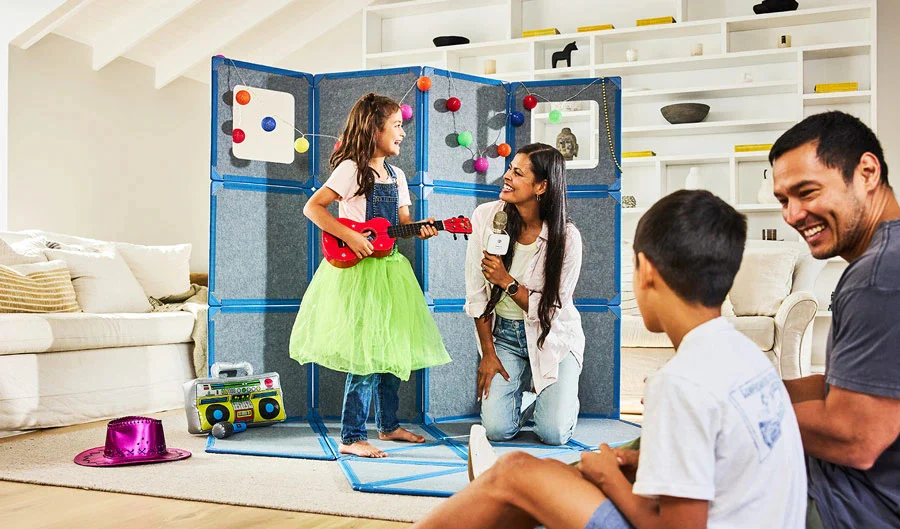Have you ever watched a child transform a cardboard box into a spaceship, castle, or secret cave? Children don’t just play—they create worlds. This ability to imagine without limits is something remarkable, something inherently human, and something worth nurturing. That’s exactly where Superspace comes in.
Superspace giant magnetic panels provide children with the opportunity to build in ways that are big, bold, and beautifully open-ended. No instructions. No “right” answer. Just pure, expansive creativity.
In a world where toys increasingly tell kids what to do, Superspace invites them to decide for themselves.

What Exactly Is Superspace?
At its core, Superspace is a modular construction system made of large, durable, and child-friendly magnetic panels. These panels connect securely at the edges, allowing children to build full-scale structures—yes, large enough to climb inside.
Think of it as LEGO meets architecture—but life-sized.
Children can create:
- Playhouses
- Spaceships
- Reading nooks
- Market stalls
- Obstacle tunnels
…and just about anything else.
The core idea is simple: give children the tools, and let their imagination supply the blueprint.
Why Open-Ended Play Matters
Open-ended play isn’t just fun—it’s essential for development. When children are not bound by fixed patterns or predetermined outcomes, their minds work harder—and more joyfully.
Encouraging Cognitive Growth
When a child builds a structure, they’re engaging in spatial reasoning, geometry, and engineering, even if they don’t realize it. Every “What if I try this instead?” is a problem-solving step.
They learn:
- How shapes connect
- How balance works
- How structure affects stability
- That failure is just part of trying again
This is STEM learning in its most natural form—hands-on, self-directed, and deeply meaningful.
Supporting Social and Emotional Learning
Play is where children learn how to negotiate ideas, share space, and compromise. Superspace structures often require teamwork, which means communication becomes part of the game.
And when they see their creation take shape?
They feel competent, confident, and proud.
This emotional reward reinforces curiosity and persistence.
The Design Philosophy Behind Superspace
Superspace didn’t come out of nowhere—it sits at the intersection of child development research and practical play design.
Large Scale = Large Thinking
When children build with full-scale materials, they use their whole body, not just their hands. This physical engagement activates cognitive processes tied to spatial awareness, emotional regulation, and creative reasoning.
It’s the difference between drawing a house on paper and stepping inside one you built yourself.
Magnetic Engineering and Safety
The magnetic edges are:
- Strong enough to support real structure
- Smooth and safe for little hands
- Durable for years of play
This balance allows children to build quickly, adjust ideas easily, and experiment freely.
The product is designed for children—but built like real architecture.
How Superspace Expands a Child’s World
The magic of Superspace lies in how it unlocks play patterns that grow with the child.
From Forts to Rockets
A three-year-old may build a hideaway.
A six-year-old may build a store.
A nine-year-old may build a spaceship.
The toy doesn’t become obsolete—the imagination simply becomes larger.
Problem Solving Through Building
Structures don’t always stand on the first try. Or the second.
But that moment of collapse?
It’s not failure—it’s a challenge.
Superspace encourages:
- Planning
- Experimentation
- Adaptation
- Innovation
This is the foundation of creative confidence.
A Tool for Schools, Playrooms, and Therapy
Superspace is not confined to playrooms—it’s used in classrooms, learning centers, and therapeutic environments around the world.
Montessori and Reggio Emilia Alignment
Both educational approaches emphasize:
- Child-led learning
- Sensory engagement
- Real-world construction
Superspace fits naturally into these philosophies by offering freedom with structure.
Sensory Rooms and Occupational Therapy Use
The tactile feedback of handling large panels, the physical engagement, and the soothing repetitive patterns of assembling pieces can support:
- Sensory integration needs
- Motor skill development
- Emotional self-regulation
It’s play that supports the whole child.
How to Introduce Superspace at Home
You don’t need to teach children how to use Superspace. You simply provide it and step back.
Starting Small and Letting Ideas Grow
Begin with simple structures:
- A wall
- A tunnel
- A small house
Then ask open-ended questions:
“What could we add?”
“What else could this become?”
Suddenly, the build becomes a story.
Encouraging Collaboration Among Siblings
Rather than competing for toys, children begin working toward shared goals.
Superspace doesn’t eliminate conflict—but it turns conflict into negotiation and teamwork.
Is Superspace Worth the Investment?
In a market crowded with noisy, battery-operated toys that are forgotten in a week, Superspace stands apart.
You’re not buying a “toy.”
You’re investing in:
- Creativity
- Spatial intelligence
- Confidence
- Social development
- Years of play
Its durability, versatility, and longevity make it one of the few play systems that grows with your child, not out of your home.
Conclusion
From the floor to the sky, Superspace gives children a chance to build worlds as big as their imagination. It supports cognitive growth, emotional development, and collaborative play—all while being genuinely fun.
In a world filled with limitations, Superspace is a celebration of possibility.

FAQs
1. What age group is Superspace best suited for?
Superspace is designed for children ages 3 and up, with play evolving in complexity as they grow.
2. Are the magnetic panels safe and durable?
Yes. They are engineered with child-safe edges and strong internal magnets for secure building.
3. How much space do I need at home to use Superspace?
A playroom, living room floor, or outdoor area works well. The system is flexible in size.
4. Can Superspace be used in schools or therapy centers?
Absolutely. It is widely used in Montessori, Reggio Emilia, and occupational therapy environments.
5. Does Superspace require adult instruction?
No. The best results come when children lead the play and adults simply support their ideas.









